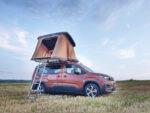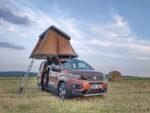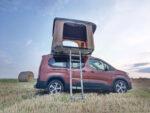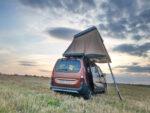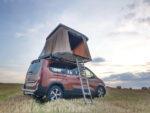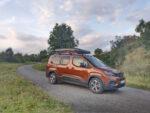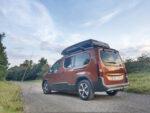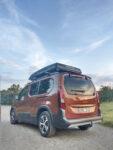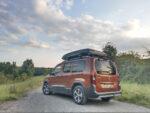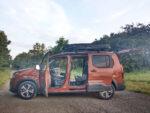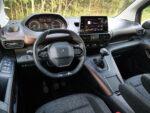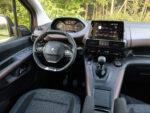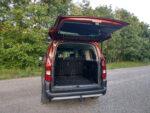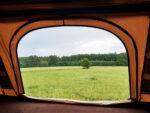Similar to last year, the Czech representative of the Peugeot car company prepared for us a car equipped with a roof tent. The combination is absolutely ideal, add a sleeping area to a spacious family MPV that does not extend into the interior of the car and you are definitely set for an adventurous week.
In this case, the very foundations of the roof tent were formed by the Rifter model in the extended Long version, which had the highest GT equipment, a seven-seat specification, the stronger of the two diesel engines and a six-speed manual. So the best that Peugeot can currently offer for this model.
The Peugeot Rifter is a representative of the MPV category, which is unfortunately on the decline these days due to the current popularity of crossovers and SUVs. On the other hand, it is still a category that definitely has a lot to offer its users.
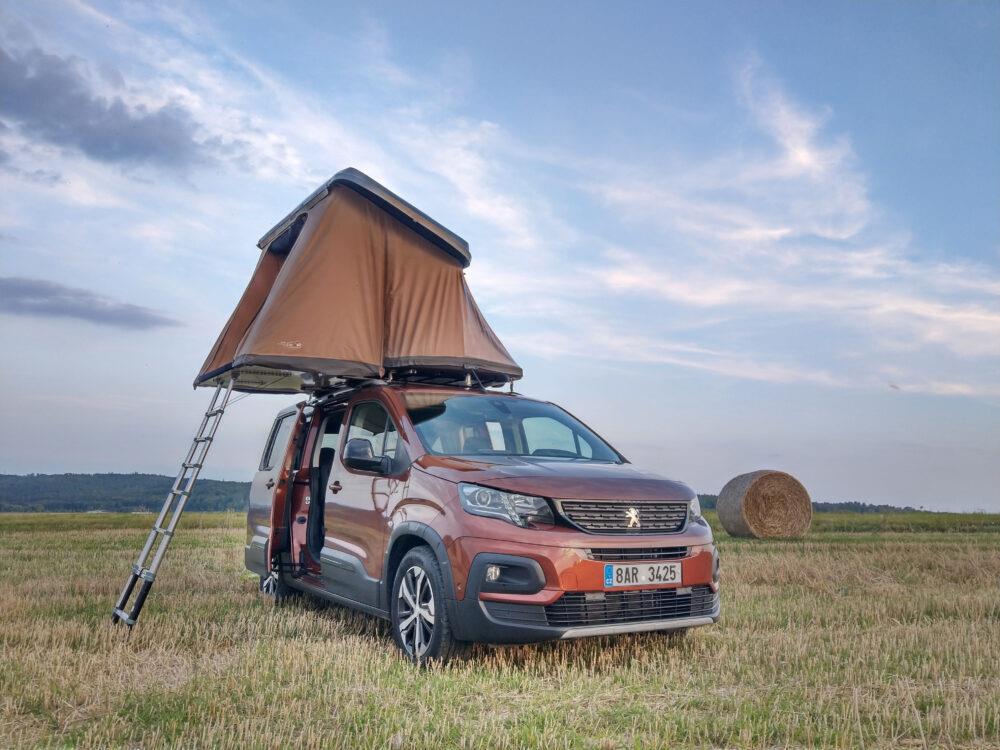
Exterior
For me, the Peugeot Rifter continues to be the best-looking model of the currently produced "siblings". Its front part (which is actually the only part where these cars are clearly and distinguishable from each other) gives a very dignified and confident impression.
The Rifter of the current generation also has a higher ground clearance and significant plastic cladding, which gives this passenger van a certain optical robustness. However, Rifter did it very carefully, and the mentioned lamination looks really decent.
The side and rear parts then bring practical, box-like proportions, which are, however, redeemed by clear advantages in the interior of the car.

Interior
According to the philosophy of the Peugeot car company, the layout of the dashboard is traditionally conceived in the spirit of the i-Cockpit. At first glance, the interior of the car is therefore very imaginative and definitely pleasing. The i-Cockpit principle also works very well in a car of this category. A small beveled steering wheel and a raised chapel with classic alarm clocks together with the on-board infotainment display play a major role in the front part of the interior. The massiveness and volume of the dashboard and central tunnel is effectively broken up by areas with different colors.
The announced on-board infotainment display then sticks out quite well from the dashboard. However, this makes it very user-friendly.
The relatively massive central tunnel has a start button, an electronic handbrake controller, an assistant controller for driving downhill, a rotary control for selecting a driving assistant and a classic six-speed manual transmission selector, which offers pleasantly short and precise shifting paths. In the tested car, the tunnel went into a voluminous storage box between the driver and passenger seats.
The interior itself is to be praised for the abundance of storage spaces, which have different shapes and positions.
The tested extended Rifter Long had a seven-seat specification, which is solved by a pair of folding and completely removable seats. Their volume will have a very pleasant effect on the comfort that this third row will offer. The luggage compartment is thus transformed into a small VIP lounge, the plastic side panels of which have ergonomically very pleasant dimensions and thus fulfill the function of a storage area.
The weight of the seats themselves has a clear overlap in the size of the luggage compartment when they are present. However, the seats can be comfortably folded down and fully folded against the seat backs of the second row. Logically, don't expect much luggage space in a full-fledged seven-seater configuration.
The second row is a trio of separate seats that have a mechanism that allows the seats to be better lowered to the floor and thus create an almost ideal plane with the plane of the trunk. The passenger seat allows you to fold down its backrest and thus allow you to transport really long objects.
The luggage compartment of the extended version in the five-seater configuration will offer 1050 liters of volume (after the horizontal partition), with the second row of seats folded down, a volume of 3500 liters.
The interior of the Peugeot Rifter generally deserves praise mainly for its spaciousness and variability. I also appreciate the i-Cockpit principle, which can make the front part of the interior special and different from its competition.

Hussarde Quatro roof tent
The currently tested Rifter was equipped with a roof tent from the company Hussarde, specifically the Quatro tent. And as the name itself suggests, this tent was designed for 4 people (ideally 2 adults and 2 children).
The roof tent is stored in a case (a roof box with dimensions of 215 x 123 x 28 cm), which is anchored through the floor of the tent structure to the transverse profiles that are attached to the roof racks of the car.
I remembered the unfolding process quite well from last year, the graphic that is pasted on the sides of the roof box will tell you the correct procedure. Basically, it's just a matter of choosing the right side to flip first. It is therefore a very simple and "one man" mechanism. When the five securing points, which are located around the perimeter of the roof box, are "clicked", the tent goes up very smoothly with your light assistance.
The tested roof tent folds on its sides, not only at the back, as in the case of the Duo version. The folding of the tent then takes place gradually, first one side and then the other. After fully folding out, the third step awaits you on the passenger side, which is to unlock the integrated ladder and flip the second part of the floor to a horizontal position.
In this way, the roof tent gets its final shape, and all you have to do is adjust the height of the floor of the unfolded part using a telescopic ladder. On the passenger side, after unfolding the tent, you now have a pleasantly covered space on the side of the car.
The floor of the tent is then equipped with a subtle folding mattress (approx. 200 x 200 cm), which offers enough comfort. The tent also has transparent mica parts and storage pockets.
As a result, the tested Hussarde Quatro roof tent is a very spacious tent that has an ingenious and very user-friendly system for unfolding and subsequent use.

Motorization and driving impressions
Under the hood of the tested car was a proven more powerful 15-cylinder diesel with a power of 96 kW (130 hp). I have been praising this engine for a long time for its quiet and refined operation, as well as for its sufficient and adequate performance for the car.
This gives the car, even with the roof box, pleasant driving dynamics while maintaining reasonable consumption, which was below the 7-liter mark during the weekly editorial test.
In this category, the car's chassis is tuned more for comfort, without any major signs of tilting. The tested car also had the Grip Control system, which adjusts the behavior of the car on different surfaces. Furthermore, an assistant that maintains a constant speed when driving downhill (steep slope).
You will only become aware of the roof box as part of the driving experience at speeds above 90 km/h, when it becomes more noisy due to the air flowing around it.
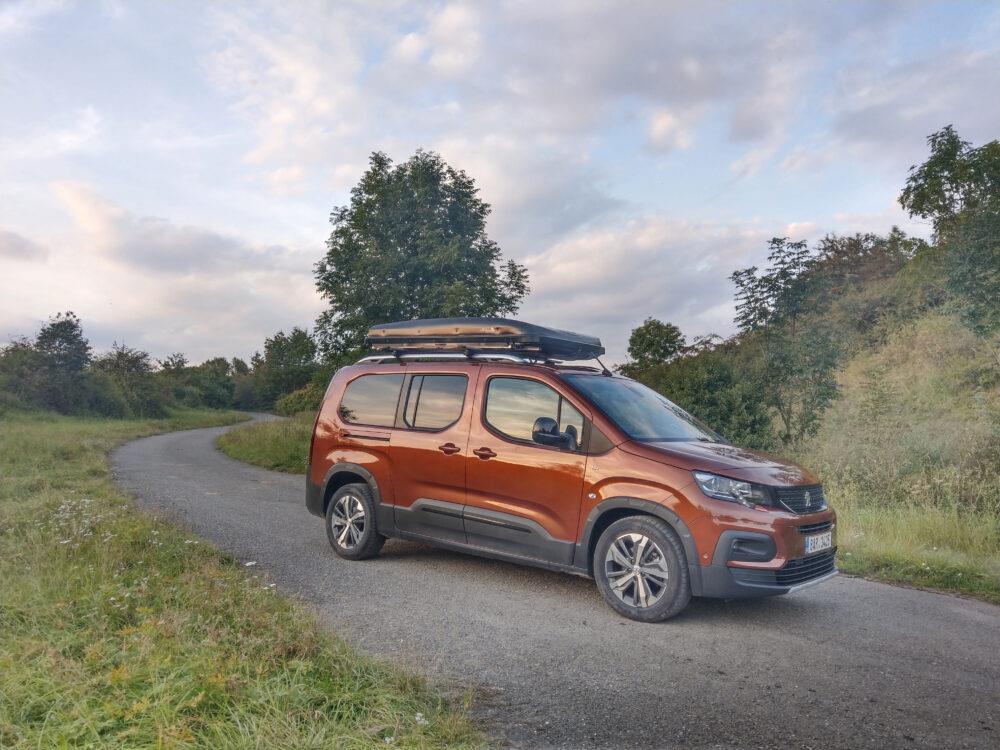
In conclusion
The basic price of the extended Rifter Long starts from CZK 475,000 including VAT. This is the basic Active Pack equipment with the PureTech 1200 petrol engine and a manual six-speed gearbox. You can buy the basic diesel 1.5 BlueHdi (100 horsepower) with a manual from CZK 506,000 including VAT.
The currently tested car, i.e. the extended Rifter Long with the highest GT equipment, can be purchased from CZK 626,000 including VAT, the car is equipped with a more powerful 15-litre diesel engine and a six-speed manual, and the seven-seat specification from CZK 646,000.
As part of the evaluation, we will first start with the Rifter itself. In the interior, this imaginative, variable and very spacious car (especially in the Long version) will also offer a comfortable driving performance, which in the case of a diesel 15-litre car does not lack enough power. Tested Rifter Long thus became a very capable foundation for a roof tent. In this case, its versatility is enriched with other pleasant options.
An inherent advantage of a roof tent is precisely its position, which usually always allows you to spend the night "in the dry". No wet subsoil or heavy night rain will surely get you down. In the case of a good location, it will allow far more interesting views. In particular, I praise the tested Hussarde Quatro tent for its unfolding system, which is really very simple and fast. Its downside can only be the higher purchase price, which in the case of a specific piece amounts to CZK 91,480 including VAT (according to the Egoe website).
Source: Author's text
Image source: Author's own photos



